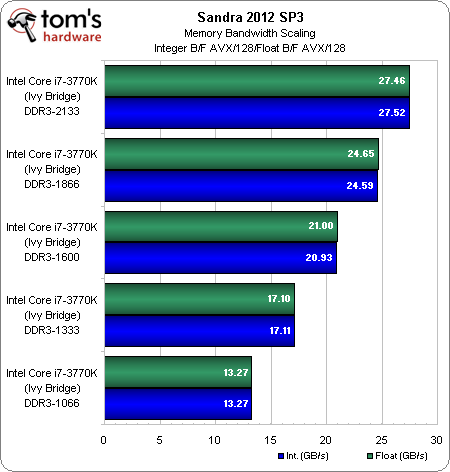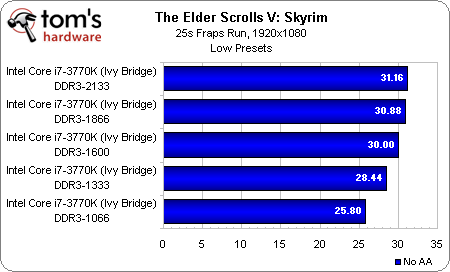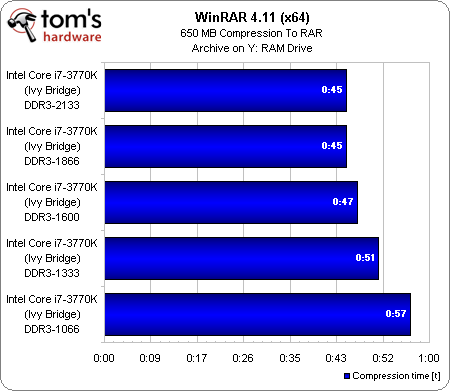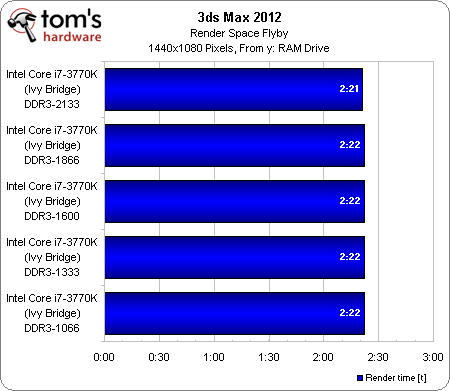Intel Core i7-3770K Review: A Small Step Up For Ivy Bridge
Ivy Bridge Memory Scaling
A deliberate effort went into extending Ivy Bridge’s memory overclocking ceiling and adding more granular settings. In theory, scaling memory bandwidth up could have a big impact on integrated graphics performance (more throughput certainly helped AMD’s A8-3850). So, is it worth spending extra on modules rated for higher data rates?
A synthetic like Sandra 2012 demonstrates sizable gains. Bandwidth literally doubles as we move from two channels of DDR3-1066 to DDR3-2133.
Real-world performance improvements trail off a lot faster though, likely because memory isn’t the most debilitating bottleneck.
Assuming you use a high-end Ivy Bridge chip with a discrete GPU, does faster memory affect our other benchmarks? WinRAR is notoriously sensitive to bandwidth changes, and it easily shows where more throughput helps…and where it ceases to make a difference.
It definitely makes sense to buy a DDR3-1600 kit, and even DDR3-1866 nudges performance forward a little. Stepping up to DDR3-2133 really doesn’t do anything though.
On the other end of the spectrum, well-threaded compute-intensive titles like 3ds Max give you nothing back in return for installing faster memory.
Get Tom's Hardware's best news and in-depth reviews, straight to your inbox.
Current page: Ivy Bridge Memory Scaling
Prev Page Overclocking Ivy Bridge: Core i7-3770K Is A Mixed Bag Next Page Test Setup And Benchmarks-
tecmo34 Nice Review Chris...Reply
Looking forward to the further information coming out this week on Ivy Bridge, as I was initially planning on buying Ivy Bridge, but now I might turn to Sandy Bridge-E -
jaquith Great and long waited review - Thanks Chris!Reply
Temps as expected are high on the IB, but better than early ES which is very good.
Those with their SB or SB-E (K/X) should be feeling good about now ;) -
xtremexx saw this just pop up on google, posted 1 min ago, anyway im probably going to update i have a core i3 2100 so this is pretty good.Reply -
ojas it's heeearrree!!!!! lol i though intel wan't launching it, been scouring the web for an hour for some mention.Reply
Now, time to read the review. :D -
zanny It gets higher temps at lower frequencies? What the hell did Intel break?Reply
I really wish they would introduce a gaming platform between their stupidly overpriced x79esque server platform and the integrated graphics chips they are pushing mainstream. 50% more transistors should be 30% or so more performance or a much smaller chip, but gamers get nothing out of Ivy Bridge. -
JAYDEEJOHN It makes sense Intel is making this its quickest ramp ever, as they see ARM on the horizon in today's changing market.Reply
They're using their process to get to places they'll need to get to in the future -
verbalizer OK after reading most of the review and definitely studying the charts;Reply
I have a few things on my mind.
1.) AMD - C'mon and get it together, you need to do better...2.) imagine if Intel made an i7-2660K or something like the i5-2550K they have now.
3.) SB-E is not for gaming (too highly priced...) compared to i7 or i5 Sandy Bridge
4.) Ivy Bridge runs hot.......
5.) IB average 3.7% faster than i7 SB and only 16% over i5 SB = not worth it
6.) AMD - C'mon and get it together, you need to do better...
(moderator edit..) -
Pezcore27 Good review.Reply
To me it shows 2 main things. 1) that Ivy didn't improve on Sandy Bridge as much as Intel was hoping it would, and 2) just how far behind AMD actually is... -
tmk221 It's a shame that this chip is marginally faster than 2700k. I guess it's all AMD fault. there is simply no pressure on Intel. Otherwise they would already moved to 8, 6, and 4 cores processors. Especially now when they have 4 cores under 77W.Reply
Yea yea I know most apps won't use 8 cores, but that's only because there was no 8 cores processors in past, not the other way around




